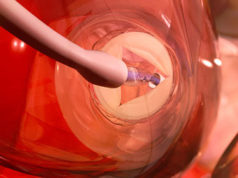A large comparative registry undertaken in a “real-world” setting has shown that, at 5 years, coronary artery bypass grafting (CABG) demonstrated lower rates of death, myocardial infarction and target vessel revascularisation compared to percutaneous coronary intervention (PCI) in patients with left main coronary artery (LMCA) or multivessel disease.
Francisco Nicolini, Department of Heart Surgery, University Medical School of Parma, Parma, Italy, presented the results at a Late-breaking trial session of the European Association for Cardio-Thoracic Surgery annual meeting (EACTS, Barcelona, Spain, 27−31 October).
“In the COOPERATION study we aimed at investigate the comparative effectiveness of CABG vs. PCI with or without drug-eluting stent or bare metal stent or PCI with drug-eluting stent only, on large cohorts of patients with similar probability of treatment assignment affected by multivessel disease or LMCA or both,” said Nicolini. Five-year outcomes were assessed in terms of death, myocardial infarction, target vessel revascularisation (TVR) and stroke, he commented.
Nicolini told delegates that from July 2002 to December 2008, 6,246 patients who underwent PCI were compared to 5,504 patients treated with CABG in 16 interventional cardiology centres and six cardiac surgery units—respectively—of the Emilia-Romagna region in Italy. “In order to reduce potential confusion and problems in selection biases we adopted propensity score matching with a subset of 2762 pairs of patients in both groups, absolutely similar in terms of cardiological and haemodynamic charateristics,” said Nicolini. The Regional Registry of Coronary Angioplasties (REAL) and Regional Registry of Cardiac Surgery (RERIC) databases were used. Information on follow-up events after hospital discharge was obtained by the Mortality Registry and the Database of Hospital Admissions.
Results
Nicolini told delegates that among the PCI patients, 50% were treated with one drug-eluting stent at least. Fifty four per cent of them received sirulimus-eluting stents and 46% paclitaxel-eluting stents. One thousand five hundred and eighty four received drug-eluting stent only. In the CABG group 5% of patients underwent off-pump surgery and 93.8% received one internal thoracic artery that was used in the revascularisation of the left anterior descending artery. Mean follow-up for all cases was 60.9±20.6 months.
Nicolini highlighted: “There were no significant differences between the two groups in the crude rates of 30-day mortality, 1.9% for PCI and 1.5% for CABG.” However, after five-year follow-up outcomes from the matched cohort showed that “PCI was associated with higher risk of death (HR=1.6 CI95% 1.4−1.8), myocardial infarction (HR=3.3 CI95% 2.7−4.0) and target vessel revascularisation (HR=45 CI95% 3.8−5.2). No significant difference was shown for stroke,” said Nicolini.
Nicoloni told delegates that the benefit of coronary artery bypass grafting was more evident on the risk of death in patients with two vessel disease and LMCA and in those with three-vessel disease with left ventricular ejection fraction <35%, congestive heart failure and diabetes. “Competing risk analysis showed that the difference in the mortality rate was due to the higher rate of myocardial infarction in PCI,” said Nicolini.
In conclusion, Nicolini said: “At five years, CABG was associated with significantly lower rates of mortality, myocardial infarction and TVR in patients with LMCA or multivessel disease than PCI, and it remains the standard of care, particularly for patients with more complex anatomy.” He acknowledged that the impact of new generation stents and improvement in PCI techniques will be evaluated in trials such as EXCEL, BEST and FREEDOM.










